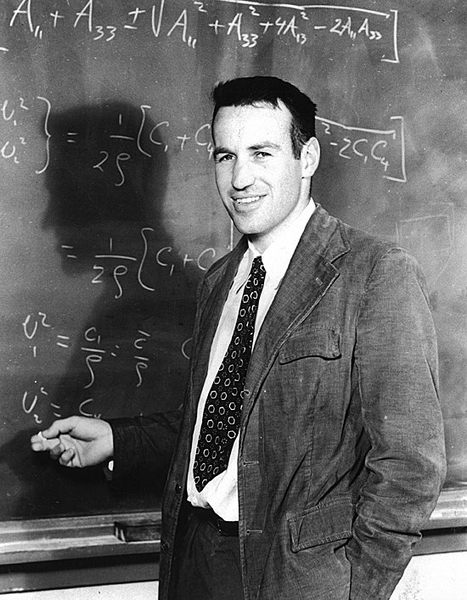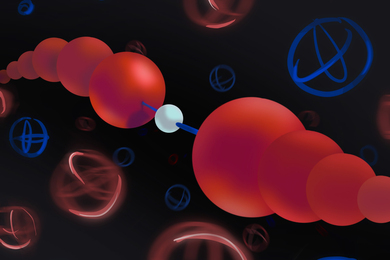Theodore Madden, or “Ted,” an MIT alumnus and professor emeritus in the Department of Earth, Atmospheric and Planetary Sciences (EAPS) whose contributions to research and teaching influenced a generation of earth scientists, died Nov. 11 at the age of 88.
Madden, who was born in 1925, entered the Institute in 1942 and never left (with the exception of a three-year stint with the U.S. Marines during World War II). He received his bachelor’s degree in physics in 1949 and his PhD in geophysics in 1961; he was already a professor of geophysics at MIT when he received his PhD. He continued teaching at the Institute until he retired in 1995.
Whether in the classroom or on the hockey rink, Madden was known for his breadth of academic interests, competitive spirit, and holistic approach to education. He was probably most celebrated for his work on methods for electrical exploration. In 1986, he received the Society of Exploration Geophysicists’ Reginald Fessenden Award in recognition of his “pioneering efforts in the development of frequency domain IP, both in practice and in theory.”
Few biographies, however, capture the scope of Madden’s research, which spanned from the core of the Earth to the outer magnetosphere, and included topics as diverse as electromagnetics, seismology, gravity waves, plasma physics, and random networks.
Madden was also an accomplished athlete who loved all sports, particularly hockey, soccer, and lacrosse, and received MIT’s award for the most outstanding athlete in 1949. He liked to say that he “majored in sports and minored in physics.” His former students remember that he brought the same intensity to athletics as he did to inverse problems.
“He was a great athlete, who wanted his students to excel in life as well as academics,” says Donald Paul, one of Madden’s former students who is now executive director of the Energy Institute, a professor of engineering, and the William M. Keck Chair of Energy Resources at the University of Southern California. “Ted also believed that if you understood the fundamentals and had diverse interests, you could do most anything. As a result, his students have been successful in a broad range of fields both within and beyond the geosciences.”
Madden is survived by his wife, Halima; his children Salim, Jennifer, and Nadia ’00; and his grandchildren Laila and Matthew. A memorial at MIT is planned for the spring semester, with further details forthcoming.
The Theodore Madden Fellowship Fund was created by EAPS on the occasion of Madden’s retirement. For more information on making a gift, please contact Dawn Adelson at dadelson@mit.edu or 617.253.0593, or visit the EAPS website at http://eapsweb.mit.edu/alumni/giving.
Madden, who was born in 1925, entered the Institute in 1942 and never left (with the exception of a three-year stint with the U.S. Marines during World War II). He received his bachelor’s degree in physics in 1949 and his PhD in geophysics in 1961; he was already a professor of geophysics at MIT when he received his PhD. He continued teaching at the Institute until he retired in 1995.
Whether in the classroom or on the hockey rink, Madden was known for his breadth of academic interests, competitive spirit, and holistic approach to education. He was probably most celebrated for his work on methods for electrical exploration. In 1986, he received the Society of Exploration Geophysicists’ Reginald Fessenden Award in recognition of his “pioneering efforts in the development of frequency domain IP, both in practice and in theory.”
Few biographies, however, capture the scope of Madden’s research, which spanned from the core of the Earth to the outer magnetosphere, and included topics as diverse as electromagnetics, seismology, gravity waves, plasma physics, and random networks.
Madden was also an accomplished athlete who loved all sports, particularly hockey, soccer, and lacrosse, and received MIT’s award for the most outstanding athlete in 1949. He liked to say that he “majored in sports and minored in physics.” His former students remember that he brought the same intensity to athletics as he did to inverse problems.
“He was a great athlete, who wanted his students to excel in life as well as academics,” says Donald Paul, one of Madden’s former students who is now executive director of the Energy Institute, a professor of engineering, and the William M. Keck Chair of Energy Resources at the University of Southern California. “Ted also believed that if you understood the fundamentals and had diverse interests, you could do most anything. As a result, his students have been successful in a broad range of fields both within and beyond the geosciences.”
Madden is survived by his wife, Halima; his children Salim, Jennifer, and Nadia ’00; and his grandchildren Laila and Matthew. A memorial at MIT is planned for the spring semester, with further details forthcoming.
The Theodore Madden Fellowship Fund was created by EAPS on the occasion of Madden’s retirement. For more information on making a gift, please contact Dawn Adelson at dadelson@mit.edu or 617.253.0593, or visit the EAPS website at http://eapsweb.mit.edu/alumni/giving.






